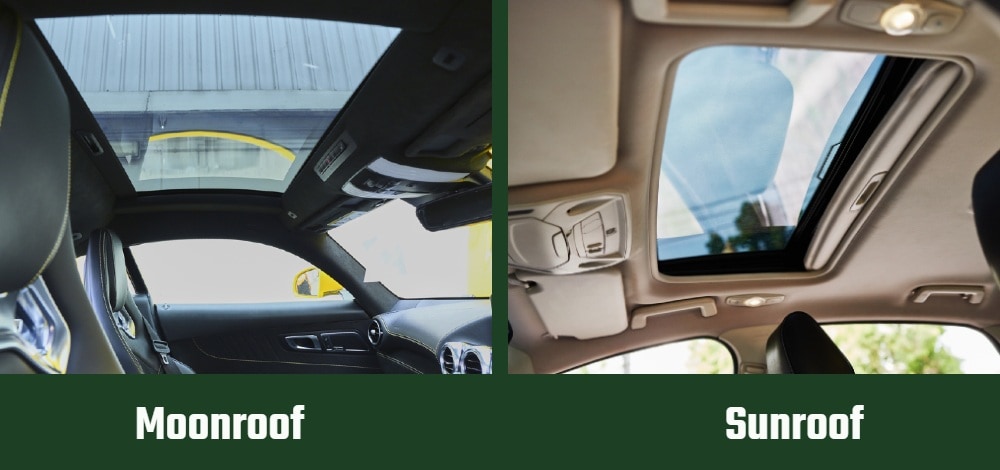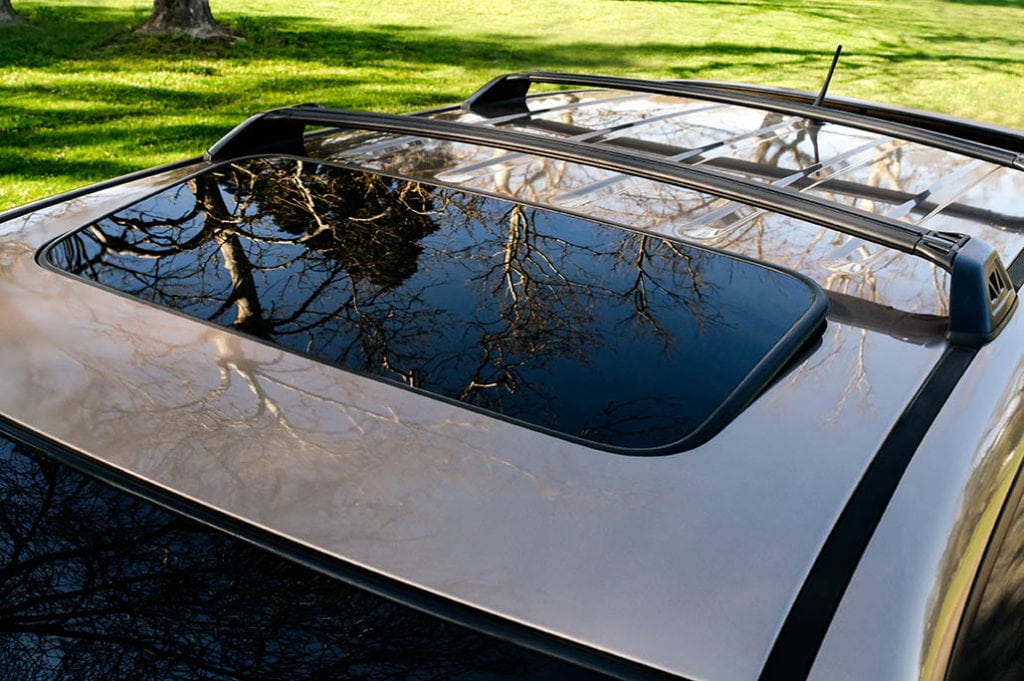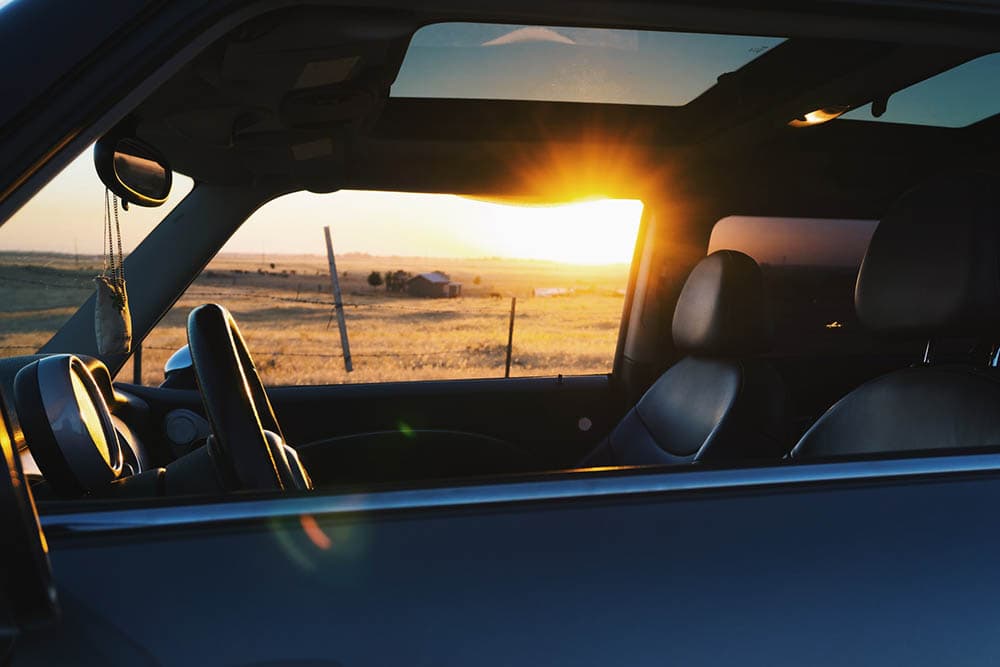Moonroof vs. Sunroof: What’s the Difference?
-
Codee Chessher
- Last updated:

The original automobiles didn’t have a roof at all, while today, we’re inundated with moonroofs, sunroofs, and convertibles—there are almost too many options! It can get a little tricky to understand the differences between these terms, but it’s not as complex as you’d think. Let’s find out exactly what the difference between a sunroof and a moonroof is.
Are a Moonroof and a Sunroof the Same Thing?
These two types of roofs are sort of the same thing in the sense that they’re both a roof that opens and closes.
There’s no official parlance differentiating the two terms, so they’re often used interchangeably. Technically, they’re completely different roofs. Because they’re both available in various types, a moonroof has been classified as a type of sunroof.
Historically, a sunroof was used to describe a roof that was opaque when closed to offer drivers a normal driving experience. However, the option to open it allowed drivers to relax, and it certainly helped airflow, too.
Moonroofs, on the other hand, are typically a piece of tinted glass that slides between the roof and the headliner. It can be tilted to allow drivers fresh air without compromising visibility or it can be completely opened to allow a view of the sky. A moonroof is often considered an archaic or outdated term and is rarely used these days.
Overview of Moonroofs
Moonroofs originated in the 1970s when a Ford marketer coined the term for the new 1973 Lincoln Mark IV’s unique sunroof that allowed a view of the sky. Instead of a metal panel like most sunroofs up to that point, Ford offered a tinted sliding glass panel that slid between the headliner and roof. It also offered an optional sunshade to block the sun if the driver wished.
Unfortunately, it didn’t take off because consumers didn’t understand how it was different from a sunroof. While variations of the original idea (a sliding roof with a view) have persisted, the original term has fallen out of favor in recent decades. Ironically, most sunroofs today are composed of glass, which technically makes them moonroofs!

Types of Moonroofs
Moonroofs are available in many, but not all, of the same types as sunroofs. Let’s check out a few of them.
- In-Built Moonroof: These are electric glass panels that you can control with switches or buttons in the car. You can open it partially to let in fresh air or fully open it. Most commonly, moonroofs slide between the roof and headliner when open.
- Panoramic Moonroof: These are specially designed moonroofs that use multiple glass panels working together to allow a full view of the sky.
- Less intrusive to headspace
- Extra daylight
- Extra light at night when the moon is out
- Can easily vent hot air and provide fresh air without running the A/C
- Poorly made moonroofs can leak
- Can reduce the car’s aerodynamics
- Can reduce fuel economy
Overview of Sunroofs
The sunroof owes its heritage to the Coup de Ville, a vintage automobile that had a removable roof. When it rained, the driver could slide the roof onto the body of the car. After cars began to adopt fully enclosed cabins as a standard, the Nash car offered the world’s first sunroof: a metal panel that could slide in or out to offer drivers a view of the sky and fresh air.
After cars became widely available, luxury automakers began to experiment with the idea of a removable roof panel. Bentley and Rolls-Royce were among the first automakers to offer a car with a sunroof. Today, most sunroofs are simply made of tinted glass, although most cars with a sunroof provide a sunshade to completely block sunlight.

Types of Sunroofs
Like moonroofs, there are many types of sunroofs. They may offer a larger glass panel, different control mechanisms, or other unique features. Let’s check out a few of the sunroofs on offer.
- In-Built Sunroof: Somewhat like a moonroof, these are glass panels that slide between the roof and headliner. Some types may be metal panels, but those types are rare.
- Pop-Up Sunroof: These are manually or electronically activated sunroofs that can be added as an aftermarket modification. Most offer various venting positions, although they may not slide completely out like in-built sunroofs.
- Panoramic Sunroof: These sunroofs are composed of multiple transparent (usually tinted) glass panels that cover the top of the cab on both the driver and passenger seat. Some may slide open for air and light, while others may not open at all.
- Folding/Ragtop Sunroof: Uniquely European, ragtop cars let drivers slide or fold the top back for light and air. There’s usually no glass involved.
- SpoilerSunroof: These sunroofs are glass panes that tilt up and out of the car at a 60-degree angle, like the spoiler on the back of a car.
- Allows fresh air without running the A/C
- Provides extra light for visibility
- Typically comes with various venting positions
- Many styles mean that virtually any driver can find a sunroof that fits their lifestyle
- Not all sunroof styles are available on all car types
- May be intrusive to headspace
- Might leak if maintenance is neglected
- Can provide thieves a point of ingress
Conclusion
While moonroof as a term might be out of style, modern sunroofs are basically the same thing. There are tons of different styles and design choices for sunroofs, but not all of them will be available for all makes and models.
Featured Image Credit: (L) Moonroof, JADEZMITH, Shutterstock | (R) Sunroof, Sompetch Khanakornpratip, Shutterstock
Contents


